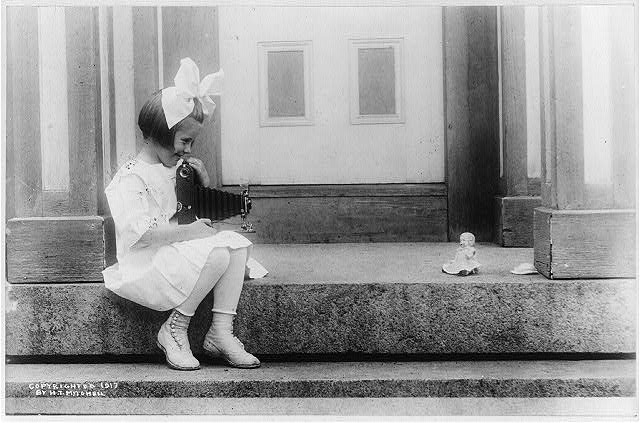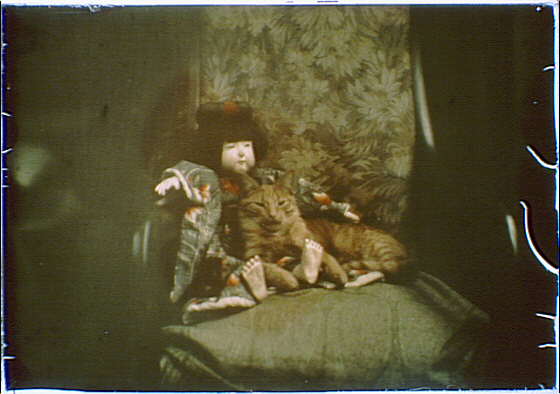
Primary Sources:
1929 Christmas Toy Catalog. (1929). F.A.O. Schwartz. https://www.oldwoodtoys.com/new_page_78.htm
Can You Tell? (1927, October 26). The New York Amsterdam News (1922-1938), 14. ProQuest Historical Newspapers: New York Amsterdam News.
Clark, K. B., & Clark, M. P. (1950). Emotional Factors in Racial Identification and Preference in Negro Children. The Journal of Negro Education, 19(3), 341–350. JSTOR. https://doi.org/10.2307/2966491
Display Ad 1—No Title. (1922, December 6). The New York Amsterdam News, 2. ProQuest Historical Newspapers: New York Amsterdam News.
Exhibit Supply Company. (1923). The Doll’s Birthday Party [Photograph]. Library of Congress. https://www.loc.gov/pictures/item/2024635838/
Genthe, A. (1910). May Kushland Holding a Doll [Photograph]. Library of Congress. https://www.loc.gov/pictures/item/2018704605/
Genthe, A. (1911). Buzzer the cat lying on a chair next to a doll [Photograph]. Library of Congress. https://lccn.loc.gov/2018704431
Hall, G. S., & Ellis, A. C. (1897). A Study of Dolls. E.L. Kellogg & Co.
Image 4 of The Nashville globe. (1909, December 17). The Nashville Globe. Library of Congress. https://lccn.loc.gov/sn86064259
Image 5 of The Nashville globe. (1909, December 17). The Nashville Globe. Library of Congress. https://lccn.loc.gov/sn86064259
Supplee-Biddle Hardware Company. (1931). 1931 Toy Catalog. 11.
Two Young Girls with Dolls. (1909). [Photograph]. Library of Congress. https://www.loc.gov/pictures/item/2016820420/
Waring, N. (1920, November). Dolly’s Dream. The Brownies’ Book. https://lccn.loc.gov/22001351
White, E. B. (1902). The Tea Party [Photograph]. Library of Congress. https://www.loc.gov/pictures/item/2004668491/
Young girl taking a Kodak picture of her doll. (1917). [Photograph]. Library of Congress. https://www.loc.gov/pictures/item/2003671161/

Scholarly Sources
Bernstein, R. (2011). The Scripts of Black Dolls. In Racial Innocence: Performing American Childhood From Slavery to Civil Rights (pp. 194–243). New York University.
Jacobs, M. (2008). Playing with Dolls. The Journal of the History of Childhood and Youth, 1(3), 321–328.
Less than 15 Years [Map]. In SocialExplorer.com. Census 1930 Retrieved 10 December 2024, from https://www.socialexplorer.com/a505db6a19/view
Less than 16 Years [Map]. In SocialExplorer.com. Census 1920 Retrieved 10 December 2024, from https://www.socialexplorer.com/a505db6a19/view
Martin, A. (2014). Toys with Professions: Racialized Black Dolls, 1850-1940. Journal of African Diaspora Archaeology and Heritage, 3(2), 137–158.
Martin, A. F. (2016). Racialized Black Dolls: Compilations from Catalogs and Advertisements. African Diaspora Archaeology Network. Accessed, 17.
Thomas, S. L. (2005a). The Ritual of Doll Play. In Kathy Merlock Jackson, Rituals and Patterns in Children’s Lives. University of Wisconsin Press.
Thomas, S. L. (2005b). Black Dolls As Racial Uplift: A Preliminary Report. Transforming Anthropology, 13(1), 55–56. ProQuest Central; Sociological Abstracts. https://doi.org/10.1525/tran.2005.13.1.55
Wilkinson, D. Y. (1987). The doll exhibit: A psycho-cultural analysis of black female role stereotypes. Journal of Popular Culture, 21(2), 19.